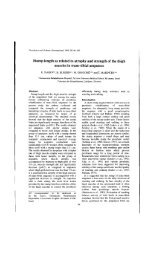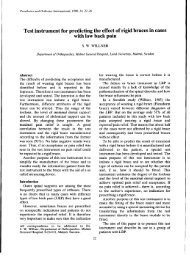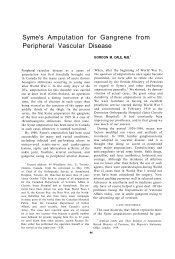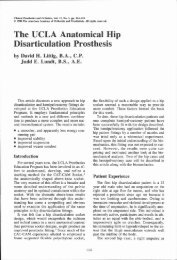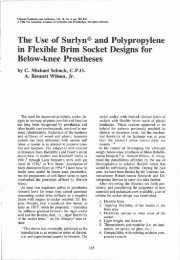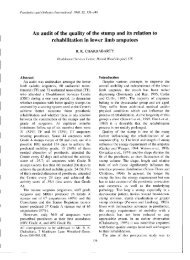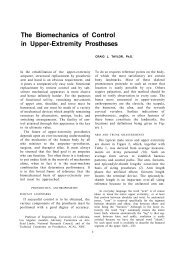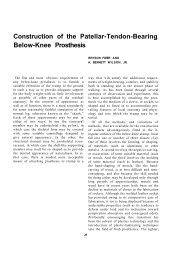Pro-Corn - O&P Library
Pro-Corn - O&P Library
Pro-Corn - O&P Library
Create successful ePaper yourself
Turn your PDF publications into a flip-book with our unique Google optimized e-Paper software.
- improved sitting comfort<br />
might include: cinematography,<br />
- improved proprioception<br />
- better heat dissipation<br />
- improved muscle activity<br />
- reduced weight<br />
- ease of socket change within frame, no<br />
loss of alignment<br />
- enhanced suspension, if suction suspension<br />
All participants agreed there is great need for improved<br />
force plate, motion analysis, gait<br />
mat and other "gait lab" studies as<br />
well as radiographical data on<br />
alignment and containment, physiological<br />
data, residual limb/socket<br />
force analysis, and/or any other relevant<br />
laboratory studies.<br />
2. A program of clinical evaluation,<br />
based on previous fittings and continuing<br />
fittings in clinics already<br />
flexible materials.<br />
III. Indications and Contraindications<br />
utilizing new fitting techniques.<br />
- there were no specific contraindications<br />
This would be a more subjective<br />
noted for any socket design<br />
study, and would require a greater<br />
- some advocated not changing successful<br />
effort for coordination and pooling<br />
quad wearers<br />
of data.<br />
- quads are most successful on long, firm<br />
3. Complete manuals should be developed<br />
for each individual technique,<br />
residual limbs with firm adductor musculature<br />
unless the developers can find it<br />
- ischial containment sockets are more<br />
successful than quads on short, fleshy<br />
residual limbs<br />
- ischial containment sockets are the<br />
mutually agreeable to work together<br />
and blend the new techniques.<br />
The panels found the latter<br />
option to be most desirable.<br />
better recommendation for high activity/sports<br />
participation/running<br />
of the developers.<br />
4. Evaluation should be independent<br />
- lack of agreement on best recommendation<br />
for bilateral above-knee<br />
nated by an authoritative group.<br />
5. Any evaluation needs to be coordi<br />
IV. Recommendations<br />
The panels' conclusions and recommendations<br />
were remarkably consistent. Most<br />
consistent was the recommendation for<br />
improved terminology, lumping what I<br />
have referred to as ischial containment into<br />
a single, workable term. Suggestions<br />
ranged from "Narrow ML" to Ischial/<br />
ISPO and/or the U.S. Veterans Administration<br />
were recommended.<br />
The American Academy of Orthotists<br />
and <strong>Pro</strong>sthetists should also be<br />
involved.<br />
6. Possible funding sources within the<br />
states include the Veterans Administration<br />
and the National Institute<br />
Ramus Containment (IRC) and Non-Ischial Containment Disability (Non-IRC). and Rehabilitation Due to<br />
time constraints, arguments about this recommendation<br />
were never resolved. It is<br />
hoped that all recommendations can be addressed<br />
in a future workshop or through<br />
some other form of action.<br />
A. Evaluation<br />
There was unanimous agreement for<br />
formal evaluation of the newer aboveknee<br />
techniques (NSNA, CAT-CAM,<br />
Shamp Narrow ML) as well as evaluation<br />
of implications of the inferiority<br />
of the quadrilateral technique.<br />
1. A program for scientific/laboratory<br />
evaluation should be set up at a<br />
center or multiple centers, depending<br />
upon resources. This study<br />
Research (NIDRR).<br />
B. Education<br />
The post-graduate,<br />
specialized<br />
courses for experienced practitioners<br />
appear to be most appropriate for<br />
teaching these newer techniques at this<br />
time. Incorporation into entry level education<br />
programs should follow as<br />
well written, experience based<br />
manuals are developed. Any teaching<br />
course should include "hands-on",<br />
patient contact, fitting, and management<br />
as part of the curriculum.<br />
C. Application<br />
The application of these new techniques,<br />
while certainly not as widespread<br />
and accepted as the quadrilat-



